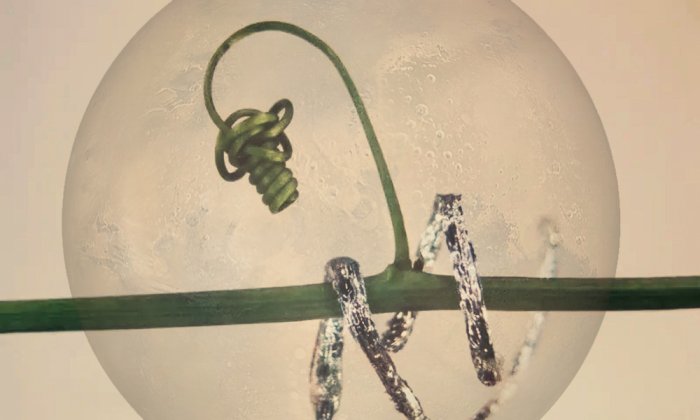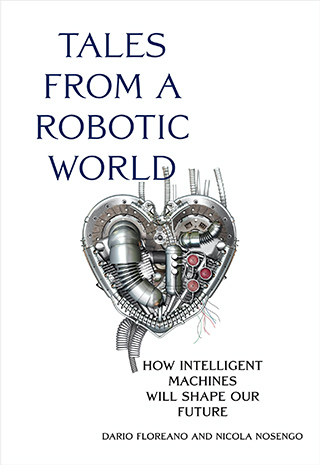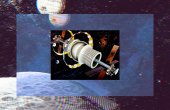The Plant-Inspired Robots That Could Colonize Mars

In the early 2010s, a new trend in robotics began to emerge. Engineers started creating robotic versions of salamanders, dragonflies, octopuses, geckos, and clams — an ecosystem of biomimicry so diverse the Economist portrayed it as “Zoobotics.” And yet Italian biologist-turned-engineer Barbara Mazzolai raised eyebrows when she proposed looking beyond animals and building a robot inspired by a totally different biological kingdom: plants. As fluid as the definition of the word robot can be, most people would agree that a robot is a machine that moves. But movement is not what plants are famous for, and so a robotic plant might at first sound, well, boring.

But plants, it turns out, are not static and boring at all; you just have to look for action in the right place and at the right timescale. When looking at the lush vegetation of a tropical forest or marveling at the colors of an English garden, it’s easy to forget that you are actually looking at only half of the plants in front of you. The best-looking parts, maybe, but not necessarily the smartest ones. What we normally see are the reproductive and digestive systems of a plant: the flowers and fruits that spread pollen and seeds and the leaves that extract energy from sunlight. But the nervous system, so to speak, that explores the environment and makes decisions is in fact underground, in the roots.
Roots may be ugly and condemned to live in darkness, but they firmly anchor the plant and constantly collect information from the soil to decide in which direction to grow to find nutrients, avoid salty soil, and prevent interference with the roots of other plants. They may not be the fastest diggers, but they’re the most efficient ones, and they can pierce the ground using only a fraction of the energy that worms, moles, or manufactured drills require. Plant roots are, in other words, a fantastic system for underground exploration — which is what inspired Mazzolai to create a robotic version of them.
“It forced us to rethink everything, from materials to sensing and control of robots.”
Mazzolai’s intellectual path is a case study in interdisciplinarity. Born and raised in Tuscany, in the Pisa area that is one of Italy’s robotic hot spots, she was fascinated early on by the study of all things living, graduating in biology from the University of Pisa and focusing on marine biology. She then became interested in monitoring the health of ecosystems, an interest that led her to get her doctorate in microengineering and eventually to be offered by Paolo Dario, a biorobotics pioneer at Pisa’s Scuola Superiore Sant’Anna, the possibility of opening a new research line on robotic technologies for environmental sensing.
It was there, in Paolo Dario’s group, that the first seeds of her plant-inspired robots were planted. Mazzolai got in touch with a group at the European Space Agency (ESA) in charge of exploring innovative technologies that looked interesting but were still far away from applications, she recalls. While brainstorming with them, she realized space engineers were struggling with a problem that plants brilliantly solved several hundred million years ago.
“In real plants, roots have two functions,” says Mazzolai. “They explore the soil in search of water and nutrients, but even more important, they anchor the plant, which would otherwise collapse and die.” Anchoring happens to be an unsolved problem when designing systems that have to sample and study distant planets or asteroids. In most cases, from the moon to Mars and distant comets and asteroids, the force of gravity is weak. Unlike on Earth, the weight of the spacecraft or rover is not always enough to keep it firmly on the ground, and the only available option is to endow the spacecraft with harpoons, extruding nails, and drills. But these systems become unreliable over time if the soil creeps, provided they work in the first place. They didn’t work for Philae, for example, the robotic lander that arrived at the 67P/Churyumov–Gerasimenko comet in 2014 after a 10-year trip only to fail to anchor at the end of its descent, bouncing away from the ground and collecting just a portion of the planned measurements.
In a brief feasibility study carried out between 2007 and 2008 for ESA, Mazzolai and her team let their imagination run free and described an anchoring system for spacecrafts inspired by plant roots. The research group also included Stefano Mancuso, a Florence-based botanist who would later gain fame for his idea that plants display “intelligent” behavior, although of a completely different sort from that of animals. Mazzolai and her team described an ideal system that would reproduce, and transfer to other planets, the ability of Earth plants to dig through the soil and anchor to it.
In the ESA study, Mazzolai imagined a spacecraft descending on a planet with a really hard landing: The impact would dig a small hole in the planetary surface, inserting a “seed” just deep enough in the soil, not too different from what happens to real seeds. From there, a robotic root would start to grow by pumping water into a series of modular small chambers that would expand and apply pressure on the soil. Even in the best-case scenario, such a system could only dig through loose and fine dust or soil. The root would have to be able to sense the underground environment and turn away from hard bedrock. Mazzolai suggested Mars as the most suitable place in the solar system to experiment with such a system — better than the moon or asteroids because of the Red Planet’s low gravity and atmospheric pressure at surface level (respectively, 1/3 and 1/10 of those found on Earth). Together with a mostly sandy soil, these conditions would make digging easier because the forces that keep soil particles together and compact them are weaker than on Earth.
At the time, ESA did not push forward with the idea of a plant-like planetary explorer. “It was too futuristic,” Mazzolai admits. “It required technology that was not yet there, and in fact still isn’t.” But she thought that others beyond the space sector would find the idea intriguing. After transitioning to the Italian Institute of Technology, in 2012, Mazzolai convinced the European Commission to fund a three-year study that would result in a plant-inspired robot, code-named Plantoid. “It was uncharted territory,” says Mazzolai. “It meant creating a robot without a predefined shape that could grow and move through soil — a robot made of independent units that would self-organize and make decisions collectively. It forced us to rethink everything, from materials to sensing and control of robots.”
The project had two big challenges: on the hardware side, how to create a growing robot, and on the software side, how to enable roots to collect and share information and use it to make collective decisions. Mazzolai and her team tackled hardware first and designed the robot’s roots as flexible, articulated, cylindrical structures with an actuation mechanism that can move their tip in different directions. Instead of the elongation mechanism devised for that initial ESA study, Mazzolai ended up designing an actual growth mechanism, essentially a miniature 3D printer that can continuously add material behind the root’s tip, thus pushing it into the soil.
It works like this. A plastic wire is wrapped around a reel stored in the robot’s central stem and is pulled toward the tip by an electric motor. Inside the tip, another motor forces the wire into a hole heated by a resistor, then pushes it out, heated and sticky, behind the tip, “the only part of the root that always remains itself,” Mazzolai explains. The tip, mounted on a ball bearing, rotates and tilts independent of the rest of the structure, and the filament is forced by metallic plates to coil around it, like the winding of a guitar string. At any given time, the new plastic layer pushes the older layer away from the tip and sticks to it. As it cools down, the plastic becomes solid and creates a rigid tubular structure that stays in place even when further depositions push it above the metallic plates. Imagine winding a rope around a stick and the rope becomes rigid a few seconds after you’ve wound it. You could then push the stick a bit further, wind more rope around it, and build a longer and longer tube with the same short stick as a temporary support. The tip is the only moving part of the robot; the rest of the root only extends downward, gently but relentlessly pushing the tip against the soil.
The upper trunk and branches of the plantoid robot are populated by soft, folding leaves that gently move toward light and humidity. Plantoid leaves cannot yet transform light into energy, but Michael Graetzel, a chemistry professor at EPFL in Lausanne, Switzerland, and one of the world’s most cited scientists, has developed transparent and foldable films filled with synthetic chlorophyll capable of converting and storing electricity from light that one day could be formed into artificial leaves powering plantoid robots. “The fact that the root only applies pressure to the soil from the tip is what makes it fundamentally different from traditional drills, which are very destructive. Roots, on the contrary, look for existing soil fractures to grow into, and only if they find none, they apply just enough pressure to create a fracture themselves,” Mazzolai explains.
This new project may one day result in robot explorators that can work in dark environments with a lot of empty space, such as caves or wells.
The plantoid project has attracted a lot of attention in the robotics community because of the intriguing challenges that it combines — growth, shape shifting, collective intelligence — and because of possible new applications. Environmental monitoring is the most obvious one: The robotic roots could measure changing concentrations of chemicals in the soil, especially toxic ones, or they could prospect for water in arid soils, as well as for oil and gas — even though, by the time this technology is mature, we’d better have lost our dependence on them as energy sources on planet Earth. They could also inspire new medical devices, such as safer endoscopes that move in the body without damaging tissue. But space applications remain on Mazzolai’s radar.
Meanwhile, Mazzolai has started another plant-inspired project, called Growbot. This time the focus is on what happens over the ground, and the inspiration comes from climbing trees. “The invasiveness of climbing plants shows how successful they are from an evolutionary point of view,” she notes. “Instead of building a solid trunk, they use the extra energy for growing and moving faster than other plants. They are very efficient at using clues from the environment to find a place to anchor. They use light, chemical signals, tactile perception. They can sense if their anchoring in the soil is strong enough to support the part of the plant that is above the ground.” Here the idea is to build another growing robot, similar to the plantoid roots, that can overcome void spaces and attach to existing structures. “Whereas plantoids must face friction, grow-bots work against gravity,” she notes. This new project may one day result in robot explorators that can work in dark environments with a lot of empty space, such as caves or wells.
But for all her robots, Mazzolai is still keeping an eye on the visionary idea that started it all: planting and letting them grow on other planets. “It was too early when we first proposed it; we barely knew how to study the problem. Now I hope to start working with space agencies again.” Plant-inspired robots, she says, could not only sample the soil but also release chemicals to make it more fertile — whether on Earth or a terraformed Mars. And in addition to anchoring, she envisions a future where roboplants could be used to grow entire infrastructure from scratch. “As they grow, the roots of plantoids and the branches of a growbot would build a hollow structure that can be filled with cables or liquids,” she explains. This ability to autonomously grow the infrastructure for a functioning site would make a difference when colonizing hostile environments such as Mars, where a forest of plant-inspired robots could analyze the soil and search for water and other chemicals, creating a stable structure complete with water pipes, electrical wiring, and communication cables: the kind of structure astronauts would like to find after a year-long trip to Mars.
Dario Floreano is Director of the Laboratory of Intelligent Systems at the Swiss Federal Institute of Technology Lausanne (EPFL). He is the co-author, with Nicola Nosengo, of “Tales From a Robotic World: How Intelligent Machines Will Shape Our Future,” from which this article is excerpted.
Nicola Nosengo is a science writer and science communicator formerly based at EPFL. His work has appeared in Nature, the Economist, Wired, and other publications. He is the Chief Editor of Nature Italy.



